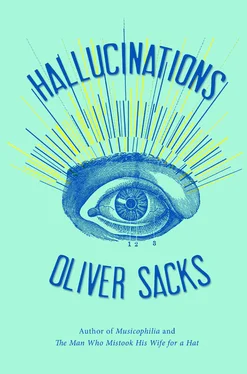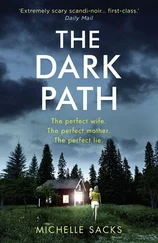My own favorite definition is that given by William James in his 1890 Principles of Psychology : “An hallucination is a strictly sensational form of consciousness, as good and true a sensation as if there were a real object there. The object happens to be not there, that is all.” Many other researchers have proposed their own definitions, and Jan Dirk Blom, in his encyclopedic Dictionary of Hallucinations , includes dozens of these.
We cannot be certain whether other animals have hallucinations, although “hallucinatory behaviors” have been observed in laboratory animals as well as in natural settings, as Ronald K. Siegel and Murray E. Jarvik described in their review of the subject.
La Barre provided an extended review of anthropological perspectives on hallucination in a chapter published in 1975.
Draaisma’s book provides not only a vivid account of Bonnet’s life and work, but fascinating reconstructions of the lives of a dozen other major figures in neurology whose names are now remembered mostly for the syndromes named after them: Georges Gilles de la Tourette, James Parkinson, Alois Alzheimer, Joseph Capgras, and others.
Or so it would seem. Recently I came across a marvelous 1845 report by Truman Abell, a physician who started to lose his sight in his fifty-ninth year and had become totally blind by 1842, four years later. He described this in an article for the Boston Medical and Surgical Journal .
“In this situation,” he wrote, “I often dreamed of having my sight restored, and of seeing the most beautiful landscapes. At length these landscapes began to appear in miniature when awake : small fields, a few feet square, would appear, clothed with green grass, and other vegetables, some in bloom. These would continue two or three minutes, and then disappear.” The landscapes were followed by an immense variety of other “illusions” — Abell did not use the word “hallucinations” — provided by “an internal sight.”
Over the course of several months, his visions increased in complexity. His “silent, but impudent visitors” were sometimes intrusive, with three or four people who would sit on his bed or “come to my bed-side, stoop down over me, and look directly into my eyes.” (Often his hallucinatory people seemed to acknowledge him, although CBS hallucinations typically do not interact with their hallucinators.) One night, he reported, “I was threatened to be run over about 10 o’clock by a drove of oxen; but having my presence of mind, I sat quiet, and with much crowding they all passed without touching me.”
Sometimes he saw ranks of thousands of people, splendidly dressed, forming columns that disappeared into the distance. At one point he saw “a column at least half a mile wide” of “men on horseback riding towards the west.… They continued to pass for several hours.”
“What I have here stated,” Abell wrote at the end of his detailed account, “must appear incredible to those unacquainted with the history of illusive visions.… How far my blindness contributed to produce such a result, I am not able to say. Never before have I been able to realize the ancient comparison of the human mind to a microcosm, or universe in miniature … [yet] the whole was confined within the organ of mental vision, and occupied, perhaps, a space of less than the tenth part of an inch square.”
A particularly good description of hallucinations in CBS (“I See Purple Flowers Everywhere”) is provided by Lylas and Marja Mogk in their excellent book Macular Degeneration , written for patients with this condition.
The reverse may also occur. Robert Teunisse told me how one of his patients, seeing a man hovering outside his nineteenth-floor apartment, assumed this was another one of his hallucinations. When the man waved at him, he did not wave back. The “hallucination” turned out to be his window washer, considerably miffed at not having his friendly wave returned.
I have heard from at least a dozen people who, like Arthur and Marjorie, hallucinate musical notation; some of them have eye problems, some parkinsonism, some see music when they have a fever or delirium, some see it hypnopompically when they awaken. All but one are amateur musicians who often spend many hours a day studying scores. This very specialized and repetitive sort of visual study is peculiar to musicians. One may read books for hours a day, but one does not usually study print itself in such an intensive way (unless one is a type designer or proofreader, perhaps).
A page of music is far more complex visually than a page of print. With musical notation, one has not just the notes themselves but a very dense set of information contained in symbols for key signatures, clefs, turns, mordents, accents, rests, holds, trills, etc. It seems likely that intensive study and practice of this complex code somehow imprints it in the brain, and should any tendency to hallucination later develop, these “neural imprints” may predispose to hallucinations of musical notation.
And yet people with no particular training or even interest in music may also have hallucinations of musical notation, as Dominic ffytche has pointed out. In a letter to me, he wrote, “although prolonged exposure to music increases the likelihood of musical eyes, it is not a prerequisite.”
I was reminded, when she said this, of a case I had heard of in which as a patient ate cherries from a bowl, they were replaced by hallucinatory cherries, a seemingly endless cornucopia of cherries, until, suddenly, the bowl was totally empty. And of another case, of a man with CBS who was picking blackberries. He picked every one he could see; then, to his delight, he saw four more he had missed — but these turned out to be hallucinations.
Something about visual movement or “optic flow” seems to be especially provocative of visual hallucinations in people with CBS or other disorders. I met one elderly psychiatrist with macular degeneration who had experienced only a single episode of CBS hallucinations: he was being driven in a car and began to see, on the edges of the parkway, elaborate eighteenth-century gardens which reminded him of Versailles. He enjoyed the experience and found it much more interesting than the ordinary view of the roadside.
Ivy L., who also has macular degeneration, wrote:
As a passenger in cars, I began riding with my eyes closed. Now I often “see” a small, moving travel scene in front of me when my eyes are shut. I “see” open roads and sky, houses, and gardens. I do not “see” any people or vehicles. The scene constantly changes, showing unidentifiable houses in great detail sliding by when the car is in motion. These hallucinations never appear except when I am in a moving car.
(Mrs. L. also reported text hallucinations as part of her CBS, “brief periods when I would ‘see’ handwriting in huge letters across a large white wall, or the income tax figures imprinted on the drapes. These lasted several years, at intervals.”)
Such correlations involve sizable regions of the brain; they are at a macro level. Correlations on a micro level, at least for elementary geometric hallucinations, have been proposed by William Burke, a neuro-physiologist who has experienced such hallucinations himself, due to macular “holes” in both eyes. He has been able to estimate the visual angles subtended by specific hallucinations and to extrapolate these into cortical distances. He concludes that the separation of his brickwork hallucinations corresponds to the separation of the physiologically active “stripes” in the V2 part of the visual cortex, while the separation of the dots he hallucinates corresponds to that of the “blobs” in the primary visual cortex. Burke hypothesizes that with diminished input from his damaged maculas, there is diminished activity in the macular cortex, releasing spontaneous activity in the cortical stripes and blobs that give rise to hallucinations.
Читать дальше












